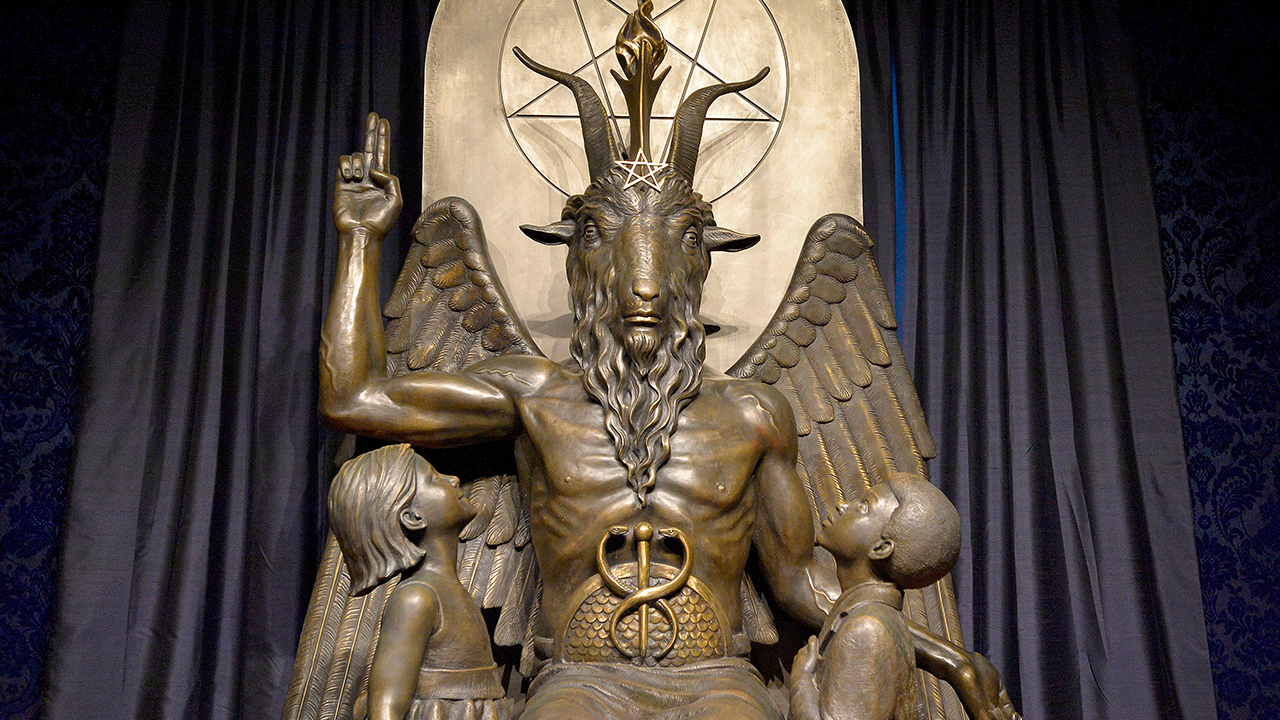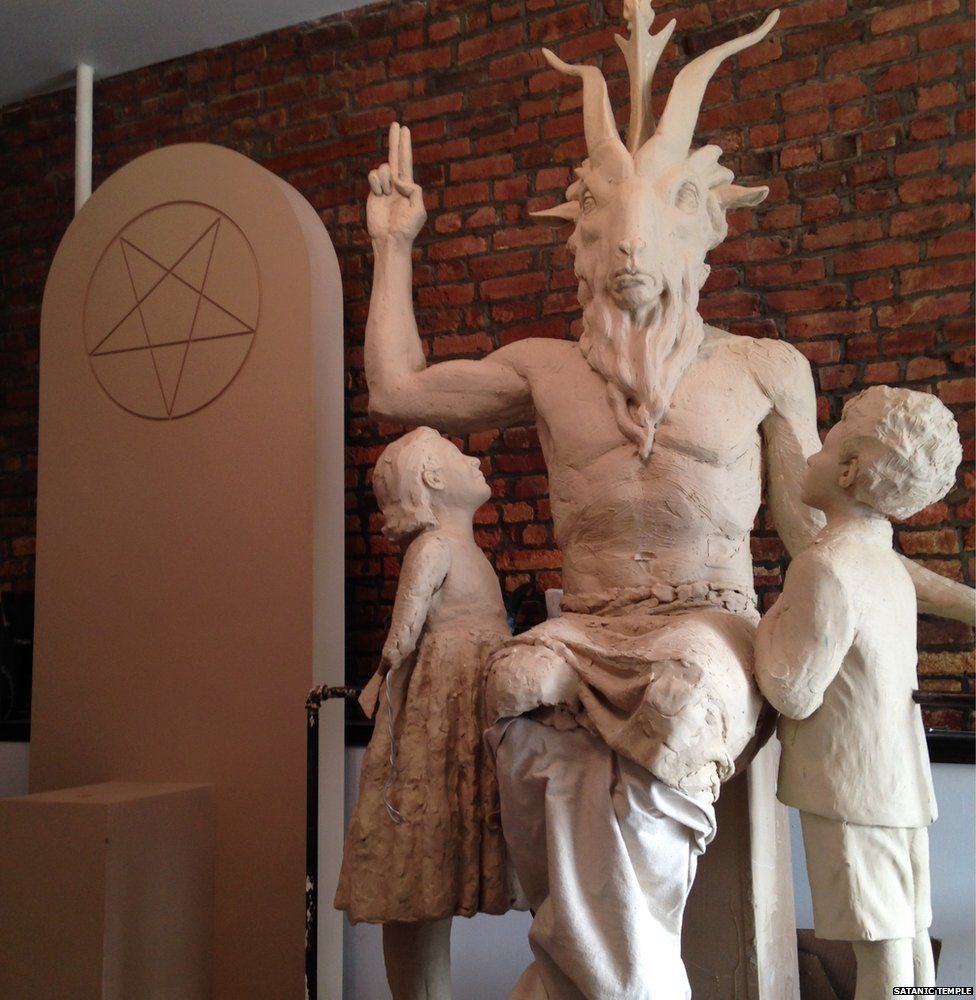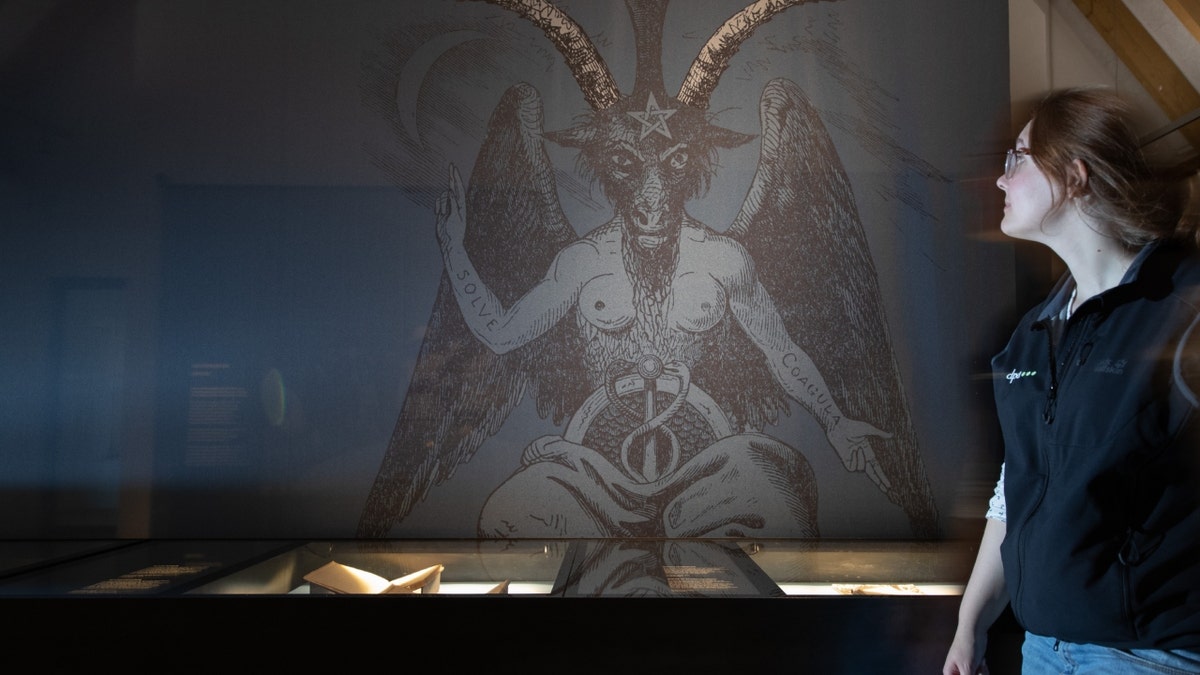Baphomet: A Transgender Symbol Of Ancient Origins
Baphomet - A Symbol of Transgender Identity
Baphomet is a deity worshipped by some occultists and Satanists, and has been adopted as a symbol of transgender identity by some people in the LGBTQ+ community.
Baphomet is often depicted as a goat-headed figure with a male body and female breasts, and is often associated with androgyny and the breaking of gender norms. This makes it a powerful symbol for transgender people, who often feel like they do not fit into traditional gender categories.
- The Complete Guide To Alex Oloughlins Children
- Meet Jeffreyean Morgan The Heartthrob Of Greys Anatomy
Baphomet Transgender
Baphomet has become a symbol of transgender identity for several reasons:- Androgyny: Baphomet's depiction as a figure with both male and female characteristics resonates with transgender individuals who identify outside of traditional gender binaries.
- Challenge to Gender Norms: Baphomet's association with Satanism and the occult represents a challenge to societal norms and expectations, aligning with the experiences of transgender people who often face discrimination and marginalization.
- Symbol of Empowerment: For transgender individuals, Baphomet represents a symbol of strength and resilience in the face of adversity, embodying the journey of self-discovery and acceptance.
Baphomet Transgender
The connection between Baphomet and transgender identity extends beyond symbolism. Baphomet has become a source of inspiration for transgender artists, activists, and performers.- Art: Baphomet-inspired artwork explores themes of gender fluidity, self-acceptance, and the breaking of societal norms.
- Activism: Transgender activists use Baphomet imagery to raise awareness about transgender issues and advocate for equality.
- Performance: Baphomet-themed performances challenge traditional gender roles and celebrate transgender identities.
Baphomet Transgender
While Baphomet provides a powerful symbol for transgender identity, its association with Satanism and the occult can also pose challenges.- Stigma: Baphomet's association with Satanism can perpetuate negative stereotypes and stigma towards transgender people.
- Appropriation: Non-transgender individuals using Baphomet imagery without understanding its significance can lead to cultural appropriation.
- Opportunities for Dialogue: Despite these challenges, Baphomet's symbolism can also open doors for dialogue and understanding about transgender identities.
Baphomet Transgender
Baphomet, a deity worshipped by some occultists and Satanists, has been adopted as a symbol of transgender identity. This multifaceted symbol holds significance in various dimensions:
- Androgyny: Baphomet's depiction as a figure with both male and female characteristics resonates with transgender individuals who identify outside of traditional gender binaries.
- Challenge to Gender Norms: Baphomet's association with Satanism and the occult represents a challenge to societal norms and expectations, aligning with the experiences of transgender people who often face discrimination and marginalization.
- Symbol of Empowerment: For transgender individuals, Baphomet represents a symbol of strength and resilience in the face of adversity, embodying the journey of self-discovery and acceptance.
- Art and Expression: Baphomet has become a source of inspiration for transgender artists, activists, and performers, who use it to explore themes of gender fluidity, self-acceptance, and the breaking of societal norms.
- Stigma and Appropriation: While Baphomet provides a powerful symbol for transgender identity, its association with Satanism and the occult can also perpetuate negative stereotypes and stigma, and its use by non-transgender individuals without understanding its significance can lead to cultural appropriation.
- Opportunities for Dialogue: Despite these challenges, Baphomet's symbolism can also open doors for dialogue and understanding about transgender identities.
These key aspects highlight the multifaceted significance of Baphomet as a symbol for transgender identity, encompassing themes of androgyny, empowerment, challenge, expression, and societal perceptions.
Androgyny
The androgynous nature of Baphomet, depicted with both male and female characteristics, holds deep significance for transgender individuals who identify outside of traditional gender binaries.
- Locate Patrick Christys Exact Location Quickly
- Lebron Jamess Relationships Personal Life And Family Dynamics
For many transgender people, Baphomet represents a symbol of liberation from societal expectations and the freedom to embrace their true gender identities. Baphomet's androgyny challenges the traditional binary view of gender, providing a powerful symbol of inclusivity and acceptance for those who do not conform to societal norms.
The connection between Baphomet's androgyny and transgender identity is rooted in the shared experience of existing outside of traditional gender categories. Just as Baphomet defies easy categorization, transgender individuals often find themselves navigating a world that does not fully understand or accept their gender identities.
Baphomet's androgyny serves as a reminder that gender is a spectrum, and that individuals should be free to express their gender identities in ways that feel authentic to them.
Challenge to Gender Norms
The connection between Baphomet's challenge to gender norms and its significance for transgender people lies in the shared experience of societal rejection and discrimination. Baphomet's association with Satanism and the occult has historically been used to vilify and marginalize those who challenge traditional societal norms, including gender norms.
Transgender individuals, who often face discrimination and marginalization for their gender identities, find resonance in Baphomet's challenge to societal norms. Baphomet's association with the occult and Satanism represents a rejection of societal expectations and a celebration of individuality, which aligns with the experiences of transgender people who often feel like outsiders in a society that does not fully understand or accept them.
Furthermore, Baphomet's androgyny and queerness challenge traditional gender roles and binaries, providing a powerful symbol of resistance and liberation for transgender individuals who seek to express their gender identities authentically.
In conclusion, Baphomet's challenge to gender norms resonates with transgender people because it represents a rejection of societal expectations, a celebration of individuality, and a symbol of resistance against discrimination and marginalization.
Symbol of Empowerment
In the context of transgender identity, Baphomet serves as a potent symbol of empowerment, embodying the strength and resilience of transgender individuals in the face of adversity.
- Overcoming Discrimination: Baphomet represents the resilience and strength of transgender individuals who navigate discrimination and prejudice. It symbolizes their refusal to be defined by societal expectations and their determination to live authentically.
- Journey of Self-Discovery: Baphomet's association with self-discovery aligns with the experiences of transgender individuals who embark on a journey of understanding and accepting their true gender identities.
- Embracing Identity: Baphomet empowers transgender individuals to embrace their identities and express themselves without fear of judgment or rejection.
- Challenging Societal Norms: Baphomet's challenge to societal norms resonates with transgender individuals who seek to break free from traditional gender roles and expectations.
Ultimately, Baphomet empowers transgender individuals by providing a symbol of strength, resilience, and self-acceptance, reminding them that they are not alone in their journey and that they deserve to be celebrated for their authenticity.
Art and Expression
The connection between art, expression, and Baphomet as a symbol of transgender identity is multifaceted and profound. Baphomet has inspired transgender artists, activists, and performers to create works that challenge traditional notions of gender, explore the complexities of gender identity, and advocate for transgender rights.
Expression of Gender Fluidity: Baphomet's androgyny and queerness have made it a powerful symbol for transgender artists who seek to express the fluidity of gender identity. Through art, they challenge the binary view of gender and celebrate the spectrum of gender expression.
Promoting Self-Acceptance: Baphomet's journey of self-discovery resonates with transgender individuals who are navigating their own journeys of self-acceptance. Artists use Baphomet's imagery to create works that encourage transgender people to embrace their true selves and find acceptance within themselves and society.
Breaking Societal Norms: Baphomet's association with the occult and Satanism has been used to challenge societal norms and expectations. Transgender activists and performers use Baphomet's symbolism to disrupt traditional gender roles and advocate for the rights of transgender individuals.
Practical Significance: The art and expression inspired by Baphomet has practical significance in raising awareness about transgender issues, challenging discrimination, and creating a more inclusive society. It provides a platform for transgender voices to be heard and for the broader public to gain a deeper understanding of gender diversity.
In conclusion, the connection between art, expression, and Baphomet as a symbol of transgender identity is vital. It empowers transgender artists to express their experiences, promotes self-acceptance, and challenges societal norms. Through art and activism, Baphomet inspires transgender individuals and advocates for their rights, contributing to a more just and inclusive society.
Stigma and Appropriation
The connection between stigma, appropriation, and Baphomet's symbolism in transgender identity is multifaceted and requires careful examination.
- Negative Stereotypes and Stigma: Baphomet's association with Satanism and the occult has historically been used to vilify and marginalize those who challenge societal norms, including gender norms. This association can perpetuate negative stereotypes and stigma towards transgender individuals who adopt Baphomet as a symbol of their identity.
- Cultural Appropriation: The use of Baphomet imagery by non-transgender individuals without understanding its significance can lead to cultural appropriation. Baphomet holds deep cultural and spiritual meaning for transgender individuals, and its adoption by non-transgender people without proper context can be seen as disrespectful and inauthentic.
- Education and Awareness: To mitigate stigma and appropriation, it is crucial to educate the broader public about the significance of Baphomet in transgender identity. This includes raising awareness about the history, symbolism, and experiences of transgender individuals who use Baphomet as a symbol of empowerment and self-expression.
- Respectful Representation: When using Baphomet imagery in art, media, or other contexts, it is essential to approach it with respect and understanding. Non-transgender individuals should be mindful of the cultural significance of Baphomet and avoid using it in ways that could be perceived as disrespectful or appropriative.
In conclusion, the connection between stigma, appropriation, and Baphomet's symbolism in transgender identity highlights the importance of understanding and respecting cultural symbols. Through education, awareness, and respectful representation, we can create a more inclusive society that embraces the diversity of gender identities and expressions.
Opportunities for Dialogue
Despite the challenges associated with Baphomet's symbolism in transgender identity, it also presents opportunities for dialogue and understanding. By exploring the multifaceted nature of Baphomet, we can foster a more inclusive society that respects and celebrates gender diversity.
- Education and Awareness: Baphomet's symbolism can serve as a catalyst for education and awareness about transgender identities. Through open discussions and respectful dialogue, we can challenge stereotypes, dispel misconceptions, and promote a deeper understanding of the experiences and perspectives of transgender individuals.
- Artistic Expression: Art inspired by Baphomet's symbolism provides a platform for transgender artists to express their experiences and perspectives. This artistic expression can foster empathy and create a space for dialogue, allowing non-transgender individuals to gain insights into the complexities of gender identity.
- Activism and Advocacy: Transgender activists and advocates use Baphomet's symbolism to raise awareness about transgender issues and advocate for equality. By engaging in dialogue and organizing events, they challenge discrimination and promote the rights of transgender individuals.
- Interfaith Dialogue: Baphomet's association with Satanism and the occult can also provide a unique opportunity for interfaith dialogue. By engaging with religious communities, we can foster understanding and dispel misconceptions about the relationship between spirituality and gender identity.
In conclusion, while Baphomet's symbolism in transgender identity presents challenges, it also offers significant opportunities for dialogue, understanding, and social change. Through education, artistic expression, activism, and interfaith dialogue, we can create a more inclusive society that embraces and celebrates the diversity of gender identities.
Frequently Asked Questions about Baphomet and Transgender Identity
This section addresses common questions and misconceptions surrounding the use of Baphomet as a symbol of transgender identity.
Question 1: Why is Baphomet a symbol of transgender identity?
Answer: Baphomet represents androgyny, challenges gender norms, and embodies strength and resilience for transgender individuals who often face discrimination and marginalization.
Question 2: How does Baphomet's symbolism empower transgender individuals?
Answer: Baphomet provides a sense of empowerment by symbolizing self-acceptance, resilience, and the breaking of societal norms, allowing transgender individuals to express their true identities authentically.
Summary: Baphomet's symbolism offers a multifaceted representation of transgender identity, fostering understanding, challenging stereotypes, and empowering transgender individuals in their journey of self-discovery and acceptance.
Baphomet Transgender
In exploring the connection between Baphomet and transgender identity, we have uncovered a multifaceted symbol that embodies androgyny, challenges societal norms, and represents strength and resilience.
Baphomet empowers transgender individuals by providing a sense of self-acceptance, encouraging them to embrace their true identities and challenge societal expectations. Art inspired by Baphomet's symbolism fosters empathy and understanding, opening doors for dialogue and social change.
As we continue to engage in respectful discussions and promote education about transgender experiences, Baphomet's symbolism will continue to play a vital role in creating a more inclusive society that celebrates the diversity of gender identities.
Article Recommendations
- Barry Williams Life Career Net Worth And Marriage Unveiled
- The Retirement Of Hasr Pol An End Of An Era For Veteran Law Enforcement Officer



Detail Author:
- Name : Oren Sporer
- Username : uleffler
- Email : tharvey@heaney.com
- Birthdate : 1980-07-01
- Address : 836 Lang Road Taliamouth, DC 54018
- Phone : 201-894-5645
- Company : Kassulke-Emard
- Job : Insulation Worker
- Bio : Aut adipisci fugit officia laborum est nulla omnis. Omnis et voluptatum nesciunt voluptatem quibusdam. Aut veniam quis consequuntur maxime qui consequatur quia aut.
Socials
linkedin:
- url : https://linkedin.com/in/euna.o'kon
- username : euna.o'kon
- bio : Omnis nam deserunt sit dolorem atque magni.
- followers : 6997
- following : 591
tiktok:
- url : https://tiktok.com/@euna8722
- username : euna8722
- bio : Et fugit autem dolorem vitae dolorem quia.
- followers : 758
- following : 1575
twitter:
- url : https://twitter.com/euna_dev
- username : euna_dev
- bio : Rem provident autem quas quo. Atque veritatis provident voluptas. Et eos exercitationem voluptatem optio.
- followers : 2272
- following : 876
facebook:
- url : https://facebook.com/euna_o'kon
- username : euna_o'kon
- bio : Mollitia quam sunt impedit culpa qui.
- followers : 1372
- following : 638